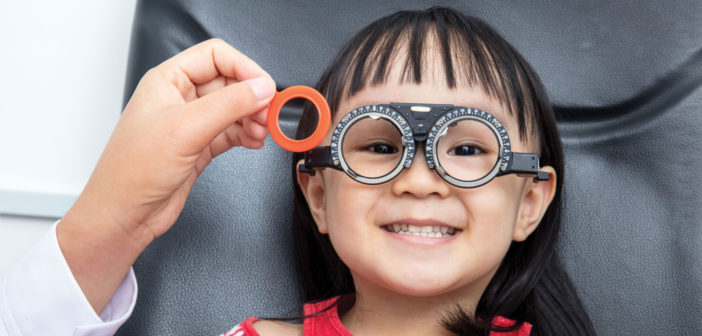Starting from birth, good vision is an integral part of a child’s physical and social development. Just as they must learn to walk and talk, babies must learn to focus their eyes and use what they see to understand the world around them.
For the first couple of weeks after birth, infants are very sensitive to light. They can see objects in their side vision, but their central vision is not well-developed. After a few weeks, they begin to focus more and after a couple of months, they can fixate on objects and follow them with their eyes. If by three months, the infant is not tracking objects, there may be a vision problem. It actually takes about five months after birth for an infant to learn to use both eyes together and achieve depth perception.
Understanding these milestones and when to check vision is important to successfully treating vision problems. The following is a guideline for checking vision in infants and children.
Newborn
For a normal full-term birth, it is recommended that a pediatrician or family physician examine the eyes and perform a “Red Reflex Test,” which can detect a wide variety of abnormalities. If the newborn is premature or at high risk for medical problems, then an ophthalmologist should do a full eye exam on the newborn.
Infant
Between the age of six months and one year, the infant should have a second vision screening by an ophthalmologist, pediatrician or family physician.
“It is important to understand that a vision screening is a baseline test to see if there might be a vision problem.”
John A. Waters, MD
Preschooler
At the age of 3-3½, a child’s eye movement and alignment should be assessed by a doctor or clinician trained in vision screenings. There are many ways to test vision at this age, including using an eye chart with pictures or using photoscreening, which doesn’t require the child to respond to the test. At this age, the child is tested for myopia (nearsightedness), hyperopia (farsightedness) and astigmatism (when the curvature of the eye is like a football). All of these may be corrected with glasses. In addition, the child is tested to make sure the eye muscles are working normally. This includes looking for signs of amblyopia (lazy eye) and strabismus (cross-eyed).
School Age
Once children enter kindergarten, the schools oftentimes perform a vision screening, which is a brief test, but not a full exam. Whether detected at school or during a doctor’s visit, children this age need to be examined for the same eye conditions as a preschooler. Once a problem is detected, an ophthalmologist or optometrist should perform a thorough exam.
John A. Waters, MD, is a board-certified ophthalmologist who regularly performs eye exams on infants and children. He recommends a comprehensive eye exam in any of the following situations:
- The child fails a vision screening
- Upon recommendation by pediatrician or school nurse
- The child has a vision complaint
- The child has a learning disability, developmental delay, or behavioral issue
- If there is a family history of pediatric eye problems, like amblyopia, strabismus, Down Syndrome, or other congenital eye diseases
“It is important to understand that a vision screening is a baseline test to see if there might be a vision problem,” Dr. Waters said. “During a comprehensive eye exam, I will dilate the eyes to clearly examine both the front and the back of the eyes and fully assess the health of the eyes and visual system.”








